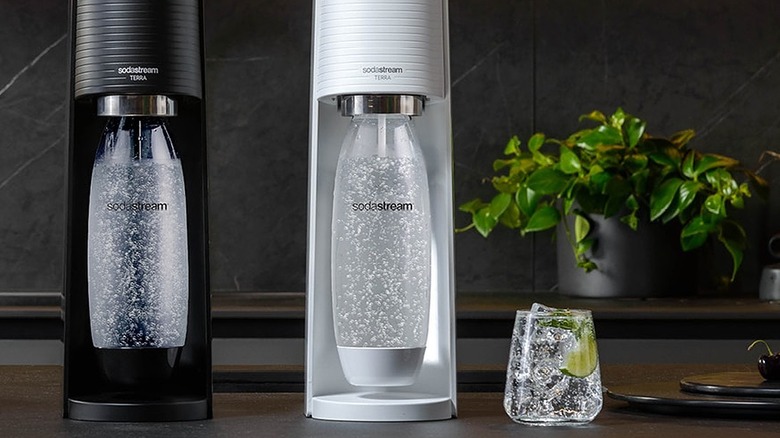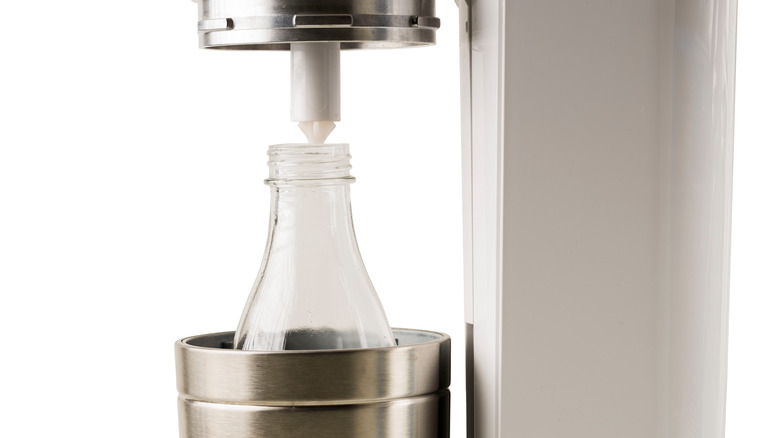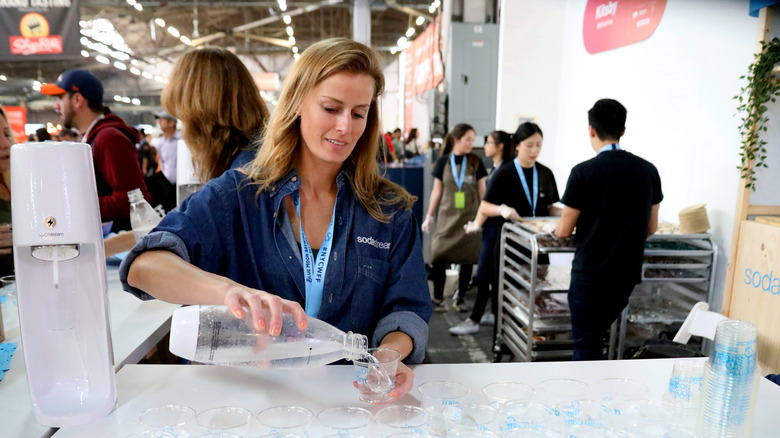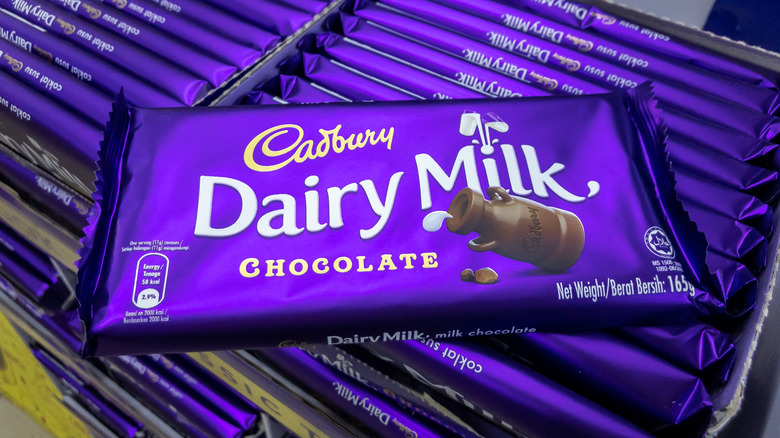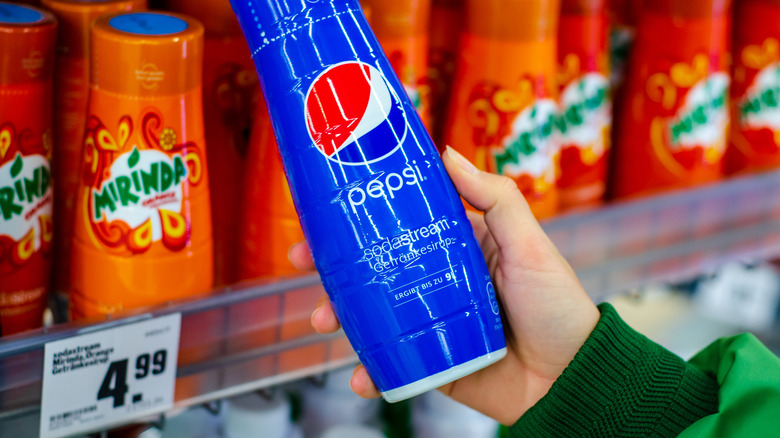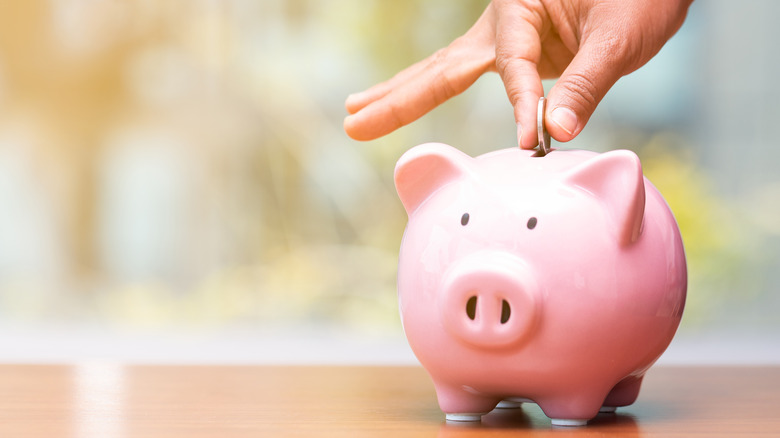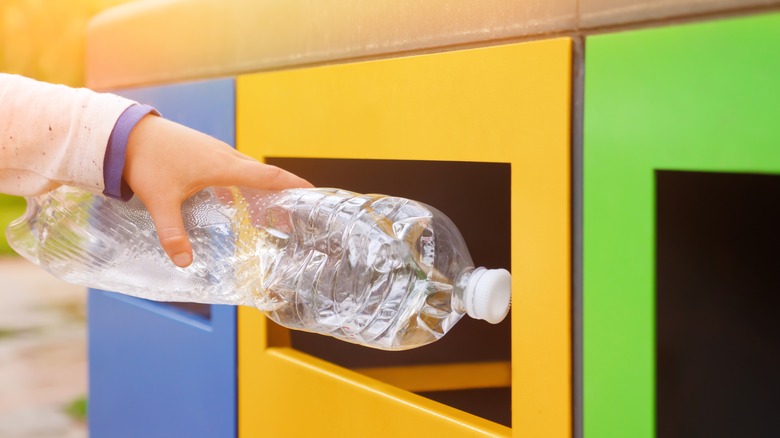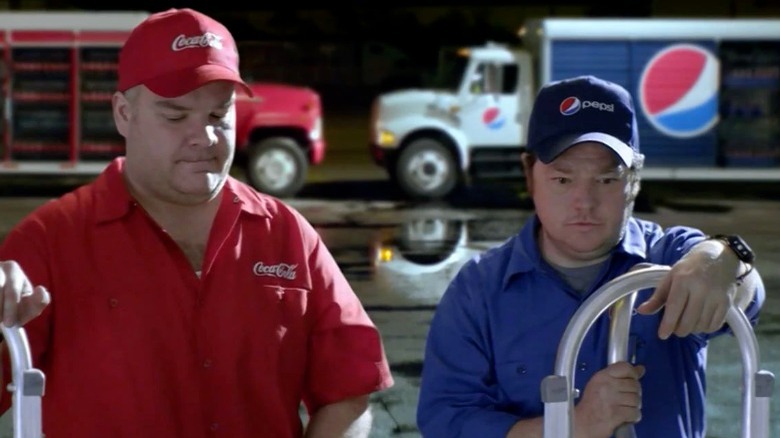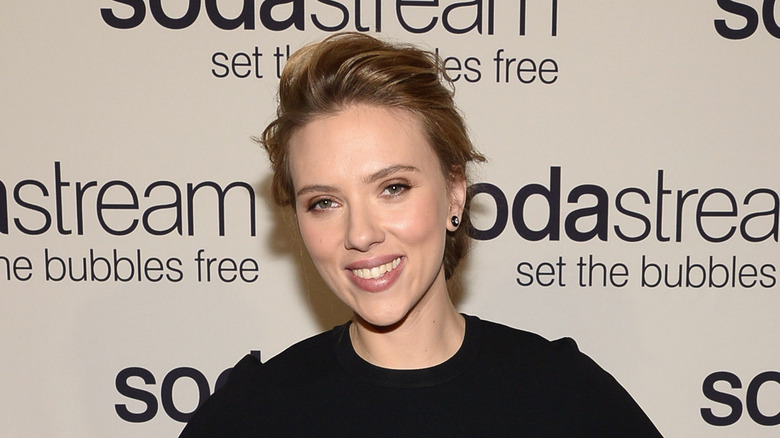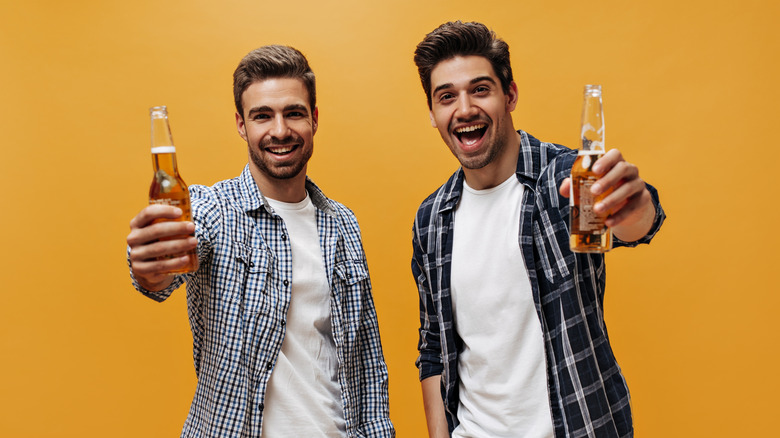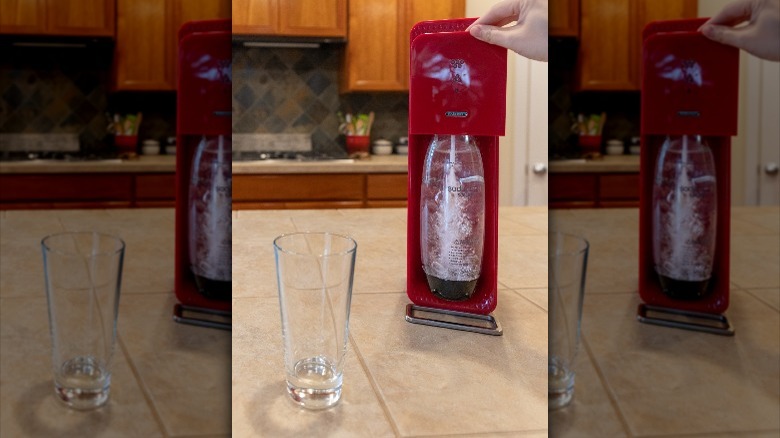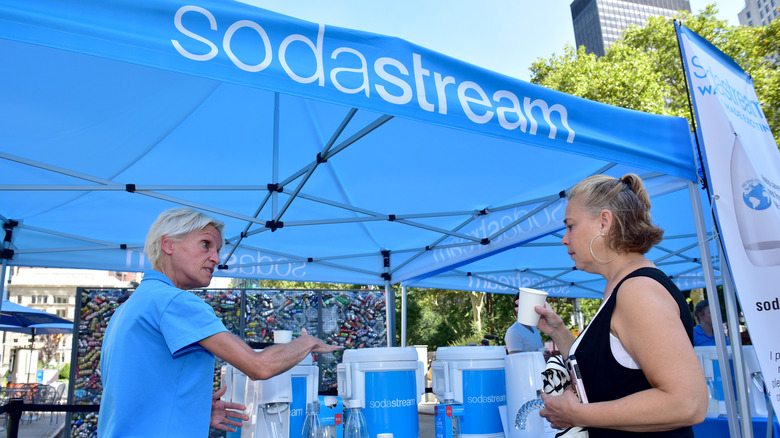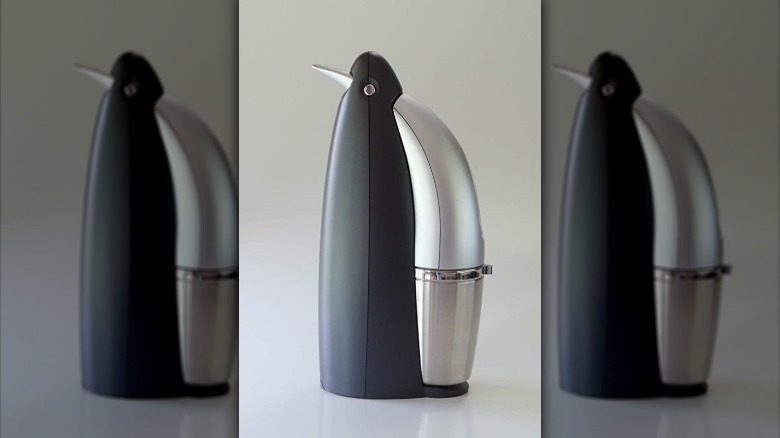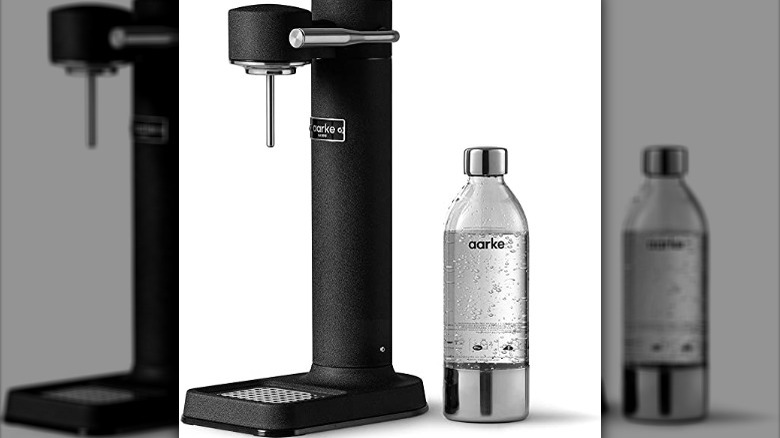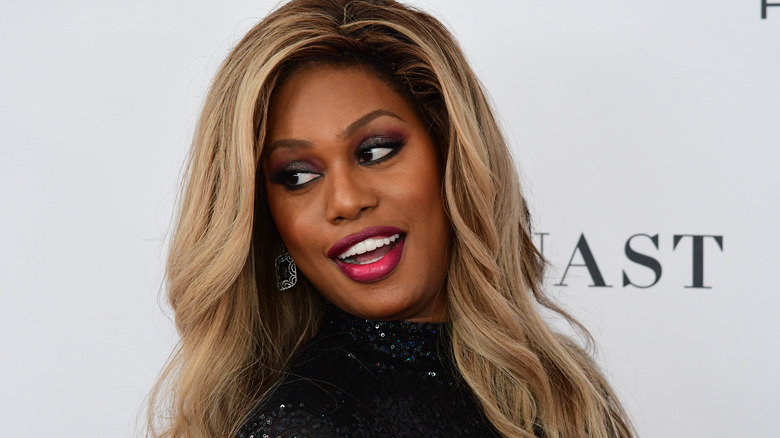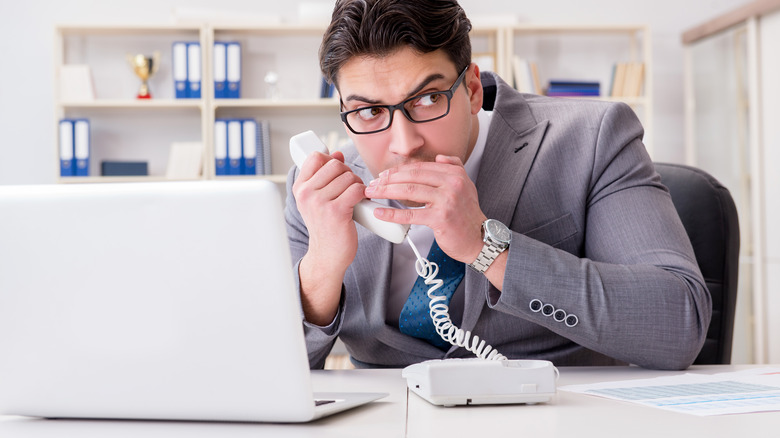The Untold Truth Of SodaStream
We may receive a commission on purchases made from links.
Sparkling water has become a growing industry in recent years, and leading the charge is SodaStream, the Israeli-based company known for its at-home carbonation machines. It's not hard to understand the surge in popularity. There's nothing more refreshing than a crisp fizzy drink, and SodaStream lets you indulge your carbonation cravings in the comfort of your own home with its easy-to-use devices. The product also boasts a wide range of diverse flavors for all tastes. Plus, the company has achieved recognition for its dedication to plastic waste reduction; each carbonator spares the environment of roughly 126 16-ounce plastic bottles, according to the company.
If you're a fan of bubbly drinks, then you've probably thought about splurging on a SodaStream machine for your very own kitchen — or maybe you're already a dedicated user. Either way, there's a lot going on below SodaStream's fizzy surface than people realize. From its rich 119-year-old history dating back to British royalty to its modern-day controversies, there's no denying SodaStream is an important industry player with a future that's equally exciting. Here's everything you need to know about SodaStream, the number one sparkling water brand.
SodaStream has actually been around for a long time
A do-it-yourself sparkling water machine might seem like an invention bespoke for modern kitchens, but SodaStream actually dates back to the turn of the century. Artificially carbonated water is even older — the first manmade carbonation was created in 1767 by British scientist Joseph Priestley. Two decades later, a Swiss entrepreneur named Jacob Schweppes — yes, that Schweppes — launched the commercial sale of carbonated beverages.
Flash forward to 1903 when a gin distiller named George Gilbey founded SodaStream in London, England. It was marketed as an aerating liquid machine, and it sold like hotcakes among the upper class including the royal family, per Forbes. SodaStream began rolling out flavored concentrates — cherry and sarsaparilla — in 1920.
When the product debuted, it was only available to the ultra-rich, but in the 1950s the company manufactured an at-home carbonation system that everyday consumers could purchase and enjoy. In 1979, SodaStream introduced a new model with a brown and beige appearance to match popular kitchen color palettes at the time. The then-trendy design inflated sales after a period of waning popularity.
Today, the SodaStream appliance has a sleeker look, part of the company's strategic push that began in 2007 after Israeli private equity firm Fortissimo Capital bought SodaStream for $10 million (via Forbes). SodaStream also hired Daniel Birnbaum, a former executive at Nike, to breathe new life into the company and turn it into the phenomena as we know it today.
SodaStream's popularity soared in Europe before it hit the U.S.
SodaStream enjoyed renewed popularity in the United Kingdom in the 1970s and '80s after the company debuted its popular commercial with the catchy "Get Busy with the Fizzy" jingle, per The Guardian. A spin-off slogan, "Get buzzy with the fizzy" followed shortly after, referencing common mixed drinks like scotch and soda (via Slate). The phrase was such a hit that it was incorporated into the company's logo where it remains to this day. Although the slogan was removed in 1996, it came back in 2010. At one point, the carbonation machine was so popular among customers in the United Kingdom that 40% of British homes had one. But SodaStream went on the rocks in the 1990s; its prevalence declined as competition from cheaper, pre-packaged drinks lured customers away.
Since then, new leadership has focused on revitalizing the brand's image and expanding its geographic reach. This includes strategic efforts to make waves in the United States. SodaStream executive Daniel Birnbaum told Forbes in 2012 that SodaStream "seemed rusty, dusty, not very exciting." Although the machines were just in 1% of stateside homes, Birnbaum noted that the company enjoyed popularity throughout Europe. He also remarked SodaStream machines were found in up to 25% of Swedish homes. SodaStream's growth strategies have certainly paid off and the same year the company went public, its revenue rose 53% (via Globes).
Cadbury Schweppes played an important role in SodaStream's growth
Key players in the Big Soda industry took notice of SodaStream's booming sales. After several changes in upper management, British conglomerate Cadbury Schweppes bought the at-home seltzer water maker company in 1985 for 22.5 million pounds, according to The Independent. Although SodaStream existed under the Cadbury Schweppes umbrella as a wholly owned subsidiary, it continued to conduct business as an autonomous entity.
The acquisition proved to be a highly strategic one. Cadbury Schweppes bought SodaStream to help it tap into the American market, as well as to position the company to compete against big-name soda brands like Pepsi and Coca-Cola. Plus, the link to Schweppes' product line allowed SodaStream to sell exclusive branded flavors like Sunkist, Fanta, Tizer, and Irn-Bru. The success of the consolidation was reflected in the numbers: Sales topped £15 million. Cadbury Schweppes' reign came to an end in 1997 when SodaStream was sold to Israeli distributor Soda-Club, per The Wall Street Journal.
PepsiCo acquired SodaStream in a huge deal
The more American customers aim to make healthier choices, the more food and beverage companies seek to accommodate their needs. In an effort to expand its product line beyond sugary sodas and salty snacks, PepsiCo bought seltzer water-maker SodaStream in a $3.2 billion cash deal in 2018 (via Vox). The acquisition was a strategic move to bolster the soft drink company's bottom line amid declining soda sales. Bottled carbonated water sales have spiked 129% since 2008, while soda sales have only grown 19% over the same period. SodaStream also stood to gain a lot from the merger, since the Israeli-based company suffered falling sales after 2013 due to growing competition from bottled and canned seltzer companies which tend to be more affordable. Plus, according to Fortune, the tie-in with Pepsi opened up SodaStream's geographic reach to about 150 more countries.
There's a surprisingly funny twist to this story since SodaStream used to frequently target Pepsi and other soda titans via advertisements and public statements. According to The Wall Street Journal, SodaStream Chief Executive Daniel Birnbaum once said about the soda company's bottled-water product LIFEWTR, "Shame on PepsiCo ... The bottled-water industry is the biggest marketing scam of all time." Ouch! It might be the union no one saw coming, but there's no denying these two industry giants are stronger together than they are apart.
The SodaStream may not save you as much money as you think
One of the main benefits of SodaStream's at-home sparkling water machine is its cost-effectiveness, according to the company website. Of course, dropping money on soda on a regular basis can really add up, but does making your own soda water at home really save you that much money in the long run? This is actually a surprisingly complicated question since the answer largely depends on how one compares the costs between a do-it-yourself seltzer machine and store-bought beverages. Do you typically buy name-brand or generic seltzers? How much sparkling water do you drink on a regular basis? Will you spend extra money on flavor concentrates?
The start-up costs are indeed more expensive for the SodaStream machine, and the most basic model costs around $66. Plus, you have to replace the CO₂ cylinder (about $30 each) regularly. You can cut down on these costs by using non-proprietary CO₂ tanks and syrup flavorings. But all in all, unless you're consuming a ton of soda daily — which comes with its own long-term health costs — SodaStream won't save you much more, if at all.
SodaStream is environmentally friendly
While a SodaStream might not save you much money, it's pretty effective at curbing environmental costs. The idea behind the device is simple: All you have to do is fill up a tank with regular tap water, affix it to the machine, and with the push of a button out comes sparkling flavored water.
If used as an alternative to canned and bottled waters and sodas, the at-home seltzer-maker machine plays a significant role in reducing plastic waste. In fact, just one SodaStream saves 3,000 single-use plastic bottles that would otherwise end up in landfills or the ocean, according to the company's website. This might seem like a fraction of the estimated 11 million tons of plastic waste that pollute the world's oceans every year, according to a study published by Pew Charitable Trusts, but every bit helps, especially if people divert their plastic use. Bonus: SodaStream owners can recycle the CO₂ cylinders needed to produce the carbonation.
As it turns out, catering to consumers' growing concern for the environment is good business sense as well. According to The Guardian, SodaStream's share price increased by more than two-fold after it rebranded itself as a green alternative to pre-packaged beverages. Well done!
SodaStream's controversial ads have been the subject of bans
In recent years, SodaStream has leveraged its environmentally savvy branding to launch eco-centric marketing campaigns. Oftentimes, the bold and brash tone of these advertising pushes has made the company a few enemies. One such campaign displayed nine cubic meter cages in prominent locations across various countries. Each cage was stuffed with 10,657 bottles and cans collected from landfills to illustrate how many single-use plastics a family uses over the course of five years (via Globes). Coca-Cola wasn't much of a fan and after a cage went up in 2012 in Johannesburg, South Africa, the company issued a cease and desist letter demanding SodaStream remove the display. Coke argued the cages were defamatory and thereby warranted legal action, per Forbes. SodaStream retaliated by setting up another cage in front of Coke's headquarters in Atlanta, Georgia.
The same year, a 30-second television commercial from SodaStream was banned in the United Kingdom right before it was supposed to go live because it showed "denigration of the bottled drinks market," according to a press release. The ad spot in question depicted soda bottles exploding each time someone made their own with a SodaStream machine. Undeterred, the Israeli-based company filed an appeal to reverse the decision. A year later, a similar commercial meant to air during the Super Bowl was rejected by the network because it directly targeted Coke and Pepsi, per The Daily Beast. The ad that was banned in the U.K. ran instead.
SodaStream has courted controversy for its proximity to the Israeli-Palestinian conflict
SodaStream might seem like an innocent concoction — there's nothing inherently insidious about fizzy drinks — but the Israeli-based company has garnered critics because of its manufacturing plant in Israeli-occupied West Bank (via The Verge). This galvanized activists to launch a boycott campaign in 2012. It's speculated that the pressure led SodaStream to shut down its facility and relocate; however, the company said the decision to launch its flagship facility elsewhere in Israel was driven by "purely commercial" reasons. Apparently, the Israeli government financed the move for $20 million. The controversy hit SodaStream hard, with shares falling more than 50% that year and retail companies removing the seltzer machines from their inventories.
Even A-list celebrities have gotten swept up in the controversy. Scarlett Johannsson faced staunch criticism after SodaStream named her their brand ambassador in 2014 (via BBC). In particular, British charity organization Oxfam expressed disapproval against the Jewish-American actress who had also served as their ambassador for eight years. In the end, she decided to terminate her role at Oxfam.
More recently, plenty of Instagram users sounded off on Martha Stewart after she posted a video in which she heaped praises on the do-it-yourself seltzer company. Some users agreed, with one commenting, "Love you girl, save the planet." Other comments were more critical, writing, "SodaStream is not a nice company. Learn what they did to Palestinians. Catch up Martha!"
There are surprising ways you can use your SodaStream machine
Don't let the name fool you. The SodaStream machine can do a lot more than fizz-ify tap water. Clever SodaStream owners have come up with fun ways to expand the utility of their machines (via CNET). For example, you can carbonate different kinds of juice — though be mindful that this is harder and messier than with plain water because of the pulp. You can even add bubbles to coffee or tea for a fun spin on classic beverages. While you can theoretically carbonate any liquid, most people use their SodaStream to add bubbles to liquor. Lighter liquors work best, while sugary or heavier liquors like rum can fall flat.
One of the best ways to use your SodaStream is to salvage open beer that's gone flat. All you have to do is pour the beer in the tank and slowly re-carbonate. We promise it'll taste like you just cracked open a cold one from the fridge. SodaStream can even be used to make beer with the company's home-brewing kit aka the Beer Bar — all it requires is plain water and beer concentrate. Fair warning: Steer clear of carbonating wine. Doing so won't make your wine taste any better, and it could result in a full-on explosion.
There are a few ways to extend your SodaStream machine's life
SodaStream machines can be pricey, so it makes sense you'd want to get your money's worth and make it last as long as possible before getting a replacement. Luckily, there are a few ways to extend your SodaStream's life expectancy. To start, it's crucial you only use very cold water with your SodaStream. Doing so guarantees the gas that carbonates the water won't escape from the tank since carbon dioxide dissolves better in cold water. Be sure to also let the freshly carbonated beverage rest for a moment before you gulp away. Although you can certainly carbonate other liquids besides water such as juice, coffee, and tea, Home Healthy Soda recommends limiting the frequency of these experiments since they can wear out the carbon dioxide cylinder.
Depending on how much sparkling water you consume on a regular basis, you might want to invest in one of the fancier models that are bound to last longer. You can also drop extra cash on a 130-liter cylinder which will make 130 drinks, more than double the amount of regular-sized cylinders (via Home Healthy Soda). Your machine may start to leak over time, especially if you use it fairly frequently. All the same, no matter which model you spring for, as long as you show it some TLC you should get plenty of bang for your buck.
SodaStream has been criticized for quality and ease-of-use issues
There's no denying the at-home water carbonator product has something resembling a cult following. But you can't please everyone and SodaStream is no exception. For some customers, the experience using the seltzer maker left them unimpressed. According to The Motley Fool, the quality of SodaStream's carbonated waters and sodas can be inconsistent, because the levels of carbonation or syrup vary while preparing a drink. This can lead to bad batches getting tossed into the trash, and ultimately a waste of money. By comparison, you can bet store-bought brands like LaCroix and Spindrift will taste the same every time no matter what.
Other consumers have expressed annoyance over the lack of availability of CO₂ cartridge refills, the biggest ease-of-use issue for SodaStream customers (via WasteDive). Elizabeth Balkan, director of North American programs for Reloop says that even when the cartridges are in stock, people often hoard them. She adds, "There was even a point when I was on Amazon figuring out how to rig my own set-up and fill the tank myself."
SodaStream sells more products than you realize
When most people think about SodaStream, they imagine one of the company's sleekly designed carbonation machines. But what many don't realize is that the company has actually found a number of creative ways to repackage and sell its core product over the years. For example, in 2013 Samsung partnered with SodaStream, rolling out a unique refrigerator that dispensed the beverages, the first of its kind (via Consumer Reports).
SodaStream has released models with savvy designs in recent years, such as the Fizzi OneTouch which automates the carbonation process so your drinks are consistently tasty. They even have a model in the shape of a penguin — how cute is that? Finally, SodaStream created SodaCaps, single-use tablets that ensure consistency by adding a pre-measured amount of flavor when preparing beverages. You can bet the soda water company will come up with even more innovative products in the future.
SodaStream faces steep competition
Although the SodaStream website says it's the world's top sparkling water company, there are many other options to choose from, and some of them could even knock it from its position. Take the machine known as the Carbonator built by a brand called Aarke, which got a rave review on U.K.-based consumer lifestyle website T3. What gives this model a competitive edge over SodaStream? According to the reviewer, part of the draw is its luxurious design, though it's about double the price of SodaStream and doesn't come with gas tanks. That said, you get what you pay for, and the Carbonator carbonates more efficiently and the overall experience provides greater satisfaction.
Other brands include the affordably priced DrinkMate, which is distinguished from SodaStream in that you can use any kind of liquid in it, including juice and wine. The iSi Classic MeshSodamaker is a compact alternative, while the Spärkel Beverage System makes it easy to customize your drink's fizziness with five preset bubble levels. But according to The New York Times, SodaStream still reigns supreme in the seltzer industry because of its great-working machinery and super tasty fizz.
SodaStream partnered with Laverne Cox for Pride Month
Earlier in the year for Pride Month, SodaStream rolled out a limited edition Rainbow Story seltzer maker kit and they handpicked actress Laverne Cox to promote its LGBT-centric product, per Today. Along with the sleekly designed matte black machine, customers can also use the six multi-colored markers that come with it to decorate the seltzer maker with their personal pride stories.
Cox has expressed nothing but enthusiasm about her partnership with SodaStream, saying the campaign was an offer she couldn't refuse and signals a broader trend toward queer acceptance. "I hope when folks get their SodaStream, they will, you know, share their rainbow stories on the SodaStream, have conversations with the people in their lives about being LGBTQ+, and just the possibilities that lie before us if we come from a place of acceptance and love."
The marketing campaign also includes a beautifully animated short film that's also entitled "Rainbow Story." The video features Cox as a superhero outfitted in a dazzling rainbow cape as she narrates the audience through key milestones in her life (via YouTube). In the beginning, Cox is shown as a child who loves to dance but is bullied by her peers. Later, she grows up into a superhero and literally flies around spreading love and awareness for the LGBTQ+ community.
Former SodaStream CEO was indicted for insider trading
Recently, SodaStream attracted some bad press when it was announced that the company's former CEO Daniel Birnbaum had been indicted for insider trading. This is the same Birnbaum who led the company's transformation from a niche sparkling water brand to a genuine competitor against major soda brands like Coca-Cola and Pepsi, per Forbes. According to The Times of Israel, Birnbaum was initially investigated over suspected insider trading related to Pepsi's $3.2 billion acquisition of SodaStream.
Allegedly, Birnbaum twice divulged private information on the deal to Ayala Sara Cohen. Armed with insider information, Globes reports that Sara Cohen bought shares of the seltzer company, making a killing in the process. The pair are also facing charges of obstruction of justice for misleading the investigation. Despite the charges, the source notes that Birnbaum has maintained his innocence, quipping that the "investigation is a bubble that will burst."
